
Edward George Earle Lytton Bulwer-Lytton, 1st Baron Lytton,, was an English writer and politician. He served as a Whig member of Parliament from 1831 to 1841 and a Conservative from 1851 to 1866. He was Secretary of State for the Colonies from June 1858 to June 1859, choosing Richard Clement Moody as founder of British Columbia. He was created Baron Lytton of Knebworth in 1866.
Events from the year 1828 in the United Kingdom.
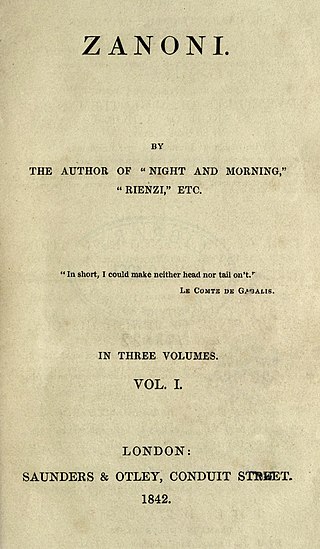
Zanoni is an 1842 novel by Edward Bulwer-Lytton, a story of love and occult aspiration. By way of introduction, the author confesses: "... It so chanced that some years ago, in my younger days, whether of authorship or life, I felt the desire to make myself acquainted with the true origins and tenets of the singular sect known by the name of Rosicrucians." A manuscript came into his hands written in what Bulwer-Lytton described as an "unintelligible cipher", a manuscript which through the author's own interpretation became Zanoni.

Fashionable novels, also called silver-fork novels, were a 19th-century genre of English literature that depicted the lives of the upper class and the aristocracy.

Rosina Bulwer-Lytton, Baroness Lytton, was an Anglo-Irish writer who published fourteen novels, a volume of essays, and a volume of letters.
Richard John Warburton Lytton was an English landowner and member of the Lytton family. He was the father of Elizabeth Barbara Lytton, and the grandfather of Henry Bulwer, 1st Baron Dalling and Bulwer and Edward Bulwer-Lytton, 1st Baron Lytton.

Flirtation is an 1827 novel by the British writer Lady Charlotte Bury, originally published in three volumes. Bury, writing anonymously, was a well-known author of silver fork novels set in high society. It was a popular success and quickly ran through three editions.

The Disowned is a novel by the British writer Edward Bulwer-Lytton, originally published in three volumes. It is part of the then-popular genre of silver fork novels, focusing on British high society of the late Regency era. Like many other silver fork novels it was published by Henry Colburn, with the first volume coming out in 1828 and the latter two in 1829. It is set in the late eighteenth century but the political and social themes it refers to have more relevance to the contemporary 1820s.

Devereux is an 1829 historical novel by the British writer Edward Bulwer-Lytton, published in three volumes. It takes place during the reign of Queen Anne and partly revolves around a secret Jacobite plot to place the pretender James Stuart on the throne. He earned £1,500 for the novel from his publisher Henry Colburn, trebling his earnings from the successful silver fork novel Pelham of the previous year. He dedicated it to his friend the Canadian traveller and writer John Auldjo, then living in Naples. The story of a sibling rivalry between three brothers may have been influenced by Bulwer-Lytton's own upbringing.
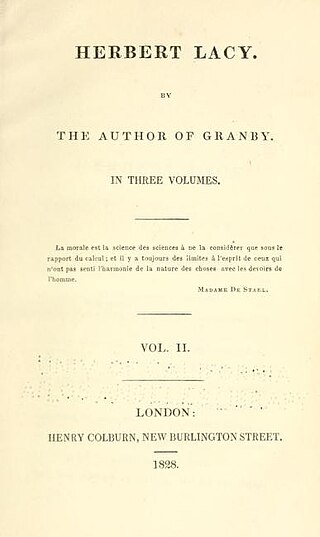
Herbert Lacy is an 1828 novel by the British writer Thomas Henry Lister, originally published in three volumes. It was part of the then-popular genre of silver fork novels depicting life in the high society of late Regency Britain. It was his second novel following Granby (1826). Much of the plot revolves around politics, with the title character elected to Parliament. It also examines the alliance between the aristocracy and growing middle classes Like many of the silver fork novels it was published by Henry Colburn.

Falkland is an 1827 Gothic novella by the British writer Edward Bulwer-Lytton. It was his first published novel and took inspiration from Johann Wolfgang von Goethe's The Sorrows of Young Werther. The protagonist was likely partly based on Bulwer-Lytton himself. The novel enjoyed success in Germany, but was criticised in Britain as immoral. It was followed by Pelham in 1828, in which he switched to the fashionable silver fork genre, which established him as leading writing in Britain and Europe.

Matilda is an 1825 novel by the British writer and politician Lord Normanby, originally published in two volumes. It was part of the emerging, popular genre of silver fork novels that focused on the fashionable British upper classes in the later Regency era, and was his first published work. He followed it with a second silver fork novel, the political Yes and No in 1828.

The Contrast is an 1832 novel by the British writer and politician Lord Normanby, originally published in three volumes. It was his third novel following Matilda (1825) and Yes and No (1828), all three of which were part of the developing silver fork genre focused on the fashionable aristocracy and upper classes of the late Regency period. It was written at the time of the Reform Act and examines the mixing of relationships across classes.

Granby is an 1826 novel by the British writer Thomas Henry Lister, published in three volumes. His first novel, it was part of the emerging genre of silver fork novels which take place in fashionable upper class settings of Regency Britain.
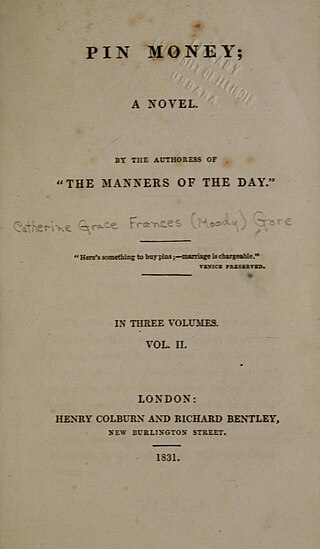
Pin Money is an 1831 novel by the British writer Catherine Gore, originally published in three volumes. It was part of the group of silver fork novels published during the later Regency era that focuses on life in the fashionable British upper classes. The Westminster Review considered the male characters to be more skilfully drawn than the female. Another review suggested that there was too much product placement in the novel, advertising the goods of various London shops.

The Cabinet Minister is an 1839 novel by the British writer Catherine Gore, originally published in three volumes. It is part of the tradition of silver fork novels popular during the era which focus on the upper-classes, and part of a subset of books which focus on British politics. It follows events in the Whig movement from the Regency Crisis of 1810 through the Great Reform Act in 1832 to the present in the early years of Queen Victoria's reign.
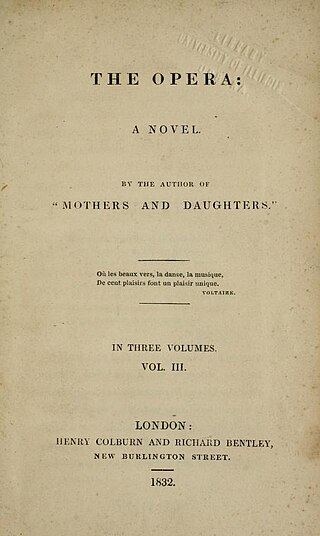
The Opera is an 1832 novel by the British writer Catherine Gore, originally published in three volumes. It is part of the tradition of silver fork novels focusing on British high society of the later Regency era. One contemporary reviewer launched a critical attack on its elitism, and lack of realism about everyday lives. The novel makes many references to the ongoing debate about the Reform Bill.
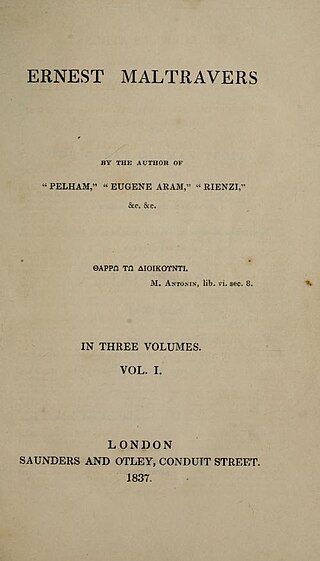
Ernest Maltravers is an 1837 novel by the British writer Edward Bulwer-Lytton, originally published in three volumes. It is Gothic in style, and features a protagonist combining "Byronic stature and Coleridgean philosophical ambition". It was followed by a sequel Alice.

Mrs. Armytage; or Female Domination is an 1836 novel by the British writer Catherine Gore, originally published in three volumes. It is a silver fork novel focusing on fashionable high society, a popular genre to which Gore contributed several books. The novel functions as an analogy for the contemporary political situation, with Gore advancing a pro-Whig viewpoint. It was very successful on its release, and was reissued by Gore's publisher Henry Colburn in 1848.

Women as They Are is an 1830 novel by the British writer Catherine Gore, originally published in three volumes.It is part of the silver fork novels focusing on fashionable high society of the later Regency era. It is also known by its subtitle The Manners of the Day. It was her first novel published by Henry Colburn, and was a considerable success. George IV described it as "the best bred and most amusing novel in my remembrance.


















